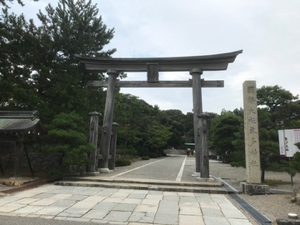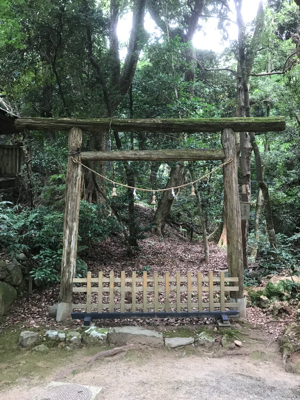 Earlier this week, I went with my daughter to visit Keta Taisha, in Ishikawa Prefecture on the west coast of Japan. That part of the prefecture is a peninsula, the Noto Peninsula, and until the administrative reforms of the late nineteenth century, it was Noto Province (Noto no Kuni). Keta Taisha was the Ichi-no-Miya, or First Jinja, of that Province. Ichi-no-Miya was not a formal designation, and arose from a local consensus as to the most important jinja in the area. Thus, there are some provinces where there are several candidates for the Ichi-no-Miya, and others, like Noto, where there is no controversy at all. All of the Ichi-no-Miya are still active jinja today, of varying degrees of importance. Some are UNESCO World Heritage sites, others are little different from any other local jinja run by a jinja family. Keta Taisha is in the middle.
Earlier this week, I went with my daughter to visit Keta Taisha, in Ishikawa Prefecture on the west coast of Japan. That part of the prefecture is a peninsula, the Noto Peninsula, and until the administrative reforms of the late nineteenth century, it was Noto Province (Noto no Kuni). Keta Taisha was the Ichi-no-Miya, or First Jinja, of that Province. Ichi-no-Miya was not a formal designation, and arose from a local consensus as to the most important jinja in the area. Thus, there are some provinces where there are several candidates for the Ichi-no-Miya, and others, like Noto, where there is no controversy at all. All of the Ichi-no-Miya are still active jinja today, of varying degrees of importance. Some are UNESCO World Heritage sites, others are little different from any other local jinja run by a jinja family. Keta Taisha is in the middle.
The main enshrined kami is Ōkuninushi, who is traditionally regarded as a kami of relationships, among many other things. Keta Taisha puts a strong emphasis on this aspect, organising a lot of festivals to pray for good relationships, encouraging people to have weddings there, and offering a wide range of “enmusubi” omamori amulets. “Enmusubi” is the Japanese term for creating or strengthening a relationship, and it often implies a romantic relationship. Keta Taisha has a range of omamori, from the basic enmusubi, through “Kokoro Musubi”, or “heart ties”, for relationships that are not necessarily romantic, to “engirienmusubi”, or “Cut the link, Tie a link”, for getting out of one relationship and into a better one.
When we were there, on a weekday, the precincts were not very busy, although there were other visitors, and a miko was stationed at the entrance to the sacred enclosure, where the main sanctuary and prayer hall are, to give us directions and point out the way we should walk. This suggests that the jinja is, sometimes, very busy. Although it is a long way from any of Japan’s main cities, there is an express train from Osaka that stops at the nearest station, and you can join that train quite close to the jinja (at Kanazawa) from the Shinkansen from Tokyo. Thus, it is not that hard to get to, and it would be possible, if a push, for most of the population of Japan to visit it on a day trip.
 There are several other jinja in the precincts, including a Tenmangū, enshrining Tenjin-sama, the most popular kami of scholarship. My daughter wanted to pay her respects at that one. The precincts also include a “forbidden forest”, a sacred woodland that people are not normally allowed to enter. The jinja describes it as a primeval forest, and it may indeed be old enough to count as that; it has been registered as a national natural monument since the 1960s, and was largely undisturbed before that. It contains the “Oku no Miya”, or “Inner Jinja”, and the priests go there only once a year, for that jinja’s main annual matsuri. The entrance to the forest has its own torii, shown in the photograph. It beautifully captures one aspect of Shinto.
There are several other jinja in the precincts, including a Tenmangū, enshrining Tenjin-sama, the most popular kami of scholarship. My daughter wanted to pay her respects at that one. The precincts also include a “forbidden forest”, a sacred woodland that people are not normally allowed to enter. The jinja describes it as a primeval forest, and it may indeed be old enough to count as that; it has been registered as a national natural monument since the 1960s, and was largely undisturbed before that. It contains the “Oku no Miya”, or “Inner Jinja”, and the priests go there only once a year, for that jinja’s main annual matsuri. The entrance to the forest has its own torii, shown in the photograph. It beautifully captures one aspect of Shinto.
One interesting thing about Keta Taisha was that I saw no male staff while I was there. The miko were, of course, female, but the priests and other staff that I saw were also female. It is clear from the pictures on the website that there are male priests there, but it is unusual for a jinja to have enough female staff, at a high enough level, for the vagaries of duty rosters to mean that everyone on duty happens to be female.
“The miko were, of course, female…” You’ve done a couple of interesting posts recently about female priests in Shinto; is there scope for one about male miko?
There’s no such thing as male miko. You can have young men in similar sorts of role, but they are not miko, and would not perform all the tasks that miko perform.
I find it extremely interesting that this shrine seems so inaccessible and remote, yet you say it is relatively easy for most of the Japanese population to access it. As an American who has to drive everywhere – sometimes for hours at a time – it seems almost impossible for something like this to be considered accessible. I find the shrine to be a true gem, and I hope that when I get the chance to travel to Japan I will be able to find myself there.
The natural elements that surround the shrine speak to the essence of Shinto, the essence of nature that flows through the religion. It is fascinating to see that the shrine itself has become a part of this, and it’s interesting how the forest has come to be protected not only by the jinja but also by the Japanese government itself.
I find it interesting that there were so many female staff members. Religious institutions are notorious for discriminating against females in their ranks, and although I know about shrine maidens, the fact that there are now members of the staff that hold even higher positions is amazing to me.
I don’t know whether “accessible” is quite the right word. You could do it in a day-trip from Tokyo, but it would be a really long day-trip. I was really trying to indicate that it is not as remote as it might initially seem, especially now that the Hokuriku Shinkansen is running. It’s certainly worth visiting if you are in Japan; get a JR pass, because one visit to Keta Taisha from Tokyo will pay for it.
I’ll address the points about female priests in response to your comment on the female priests post.
“The miko were, of course, female, but the priests and other staff that I saw were also female. It is clear from the pictures on the website that there are male priests there, but it is unusual for a jinja to have enough female staff, at a high enough level, for the vagaries of duty rosters to mean that everyone on duty happens to be female.”
Maybe they’re all hoping for love by working at the shrine of the Kami of love?